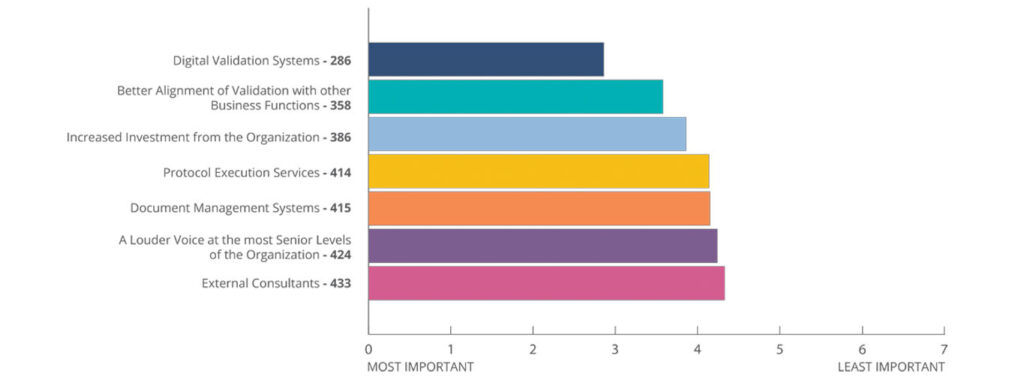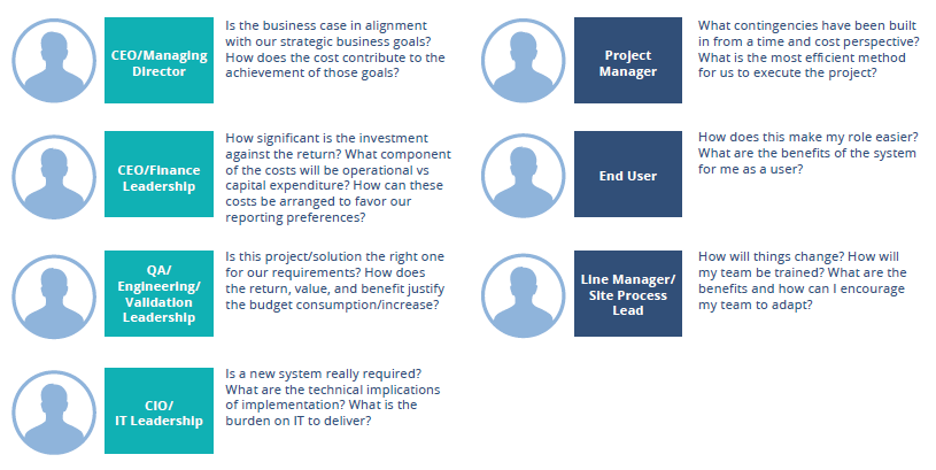Critical to the success of implementing a digital validation solution, is the ability to communicate its business and financial benefits, in order to gain get executive buy-in.
Projections suggest that 2023 will be the busiest year yet for validation activity. According to the 2022 State of Validation report—a validation industry survey and study that sheds light on the practices, trends, and pitfalls of the global validation industry—both workloads and budgets are forecast to increase this year.
The majority of survey respondents also stated that implementing a digital validation system would provide the biggest opportunity for improvement of validation at their organization.

How to Engage Senior Management

Senior stakeholders in Quality Assurance (QA), IT, and Finance act as both key decision-makers and budgetary controllers for digital validation projects. As such, it is critical to gain the understanding and support of this wider group when seeking to implement a new digital validation system.
The key to engaging senior management and gaining buy-in is explaining the benefit in terms of the key interests of the function you are engaging. For Validation the key benefit may be about cycle-time reduction, for Quality it may be about data integrity controls and audit trails, for Finance it may be about the return on investment and so on.
Some key interests of common stakeholders to digital validation projects, and things they need to know are listed below.

How to Build a Business Case Aligned to Business Goals

Effective business cases:
- Identify a known business problem or objective.
- Propose a solution to that problem.
- Outline a project to provide that solution.
- Forecast a return on investment or net present value of the proposed project; and
- Communicate other non-revenue related benefits.
Typically, a business case should identify and communicate the inefficiencies, costs, and risks created by the ‘current state’ approach, tie these drivers to a project’s objectives, outline how the solution will resolve or enhance the current state, and forecast the benefits.
Actual return can be calculated after the completion of a project, by measuring key performance indicators before and after project delivery to identify gains or efficiencies achieved, minus the total cost of ownership—a figure which is calculated by the project budget.
When building business cases for digital validation systems, emphasizing the challenges a paper-based or hybrid validation process presents staff (such as the inconvenience of printing, signing, and scanning for test execution, shipping physical documents for review and approval, or summoning documents from storage) is unlikely to gain leadership support.
Instead, aim to highlight KPIs that relate to revenue creation, production volume, and cost reduction, such as the labor-hours cost of current state approach, total cost consumed by validation in company projects, time-to-market consumed by validation, production up-time, and more.
Metrics such as these, and others based on the nature of your business, will help to position the business case in terms budget approvers can comfortably support.
By understanding the business’s problems and goals, and the role validation plays in these goals and challenges, you can identify clear areas where digital validation can have a positive impact and begin measuring. For example, if equipment changeover is frequent at your facilities, a reduction in the cycle-time to validate that change-over means a reduction in down-time, a faster return to production, and a greater throughput, resulting in higher revenue for the company.
Compliance is another determining factor. If you can show that your preferred validation software improves compliance, or that it reduces your risk of negative audit that can also be of huge value to a company. Similarly, cost comparisons of potential losses vs risk-prevention costs can also present a strong case for investment in solutions that systematically prevent risk.
When establishing a business case for digital validation software, you can draw on case studies like these to help identify cost and efficiency impacts from digital validation.
Gathering Supporting Data

Strong business cases not only align themselves to known company objectives, but they also draw on proven internal and vendor supplied data to support claimed benefits and demonstrate a return on investment. Here are some key areas to analyze when gathering supporting data for your business case:
Increased revenue
When thinking about revenue increase, examine the number and scope of validation processes affected and the enhancement of their capabilities, as well as additional revenue attributable to improved validation processes. For example, digital validation reduces validation cycle-time by up to 88% and change-over cycle-time by up to 85%, enabling a faster release to production which can increase output in continuous manufacturing environments, or increase speed to market and return in batch manufacturing.
Cost efficiency
To show cost efficiencies, start by creating an accurate inventory of existing validation and quality management tools that would potentially become redundant after the implementation of a new end-to-end management solution. Include any validation-related document management system (DMS), or project management software, that your company is currently paying for.
Get as much information about each product as possible, including contract details, the number of users and licenses, and information from key stakeholders on the frequency of use. This will help you to understand potential savings (as well as quickly identify any tools that are not delivering a return on investment for your business).
Measuring the cost of any paper-related resources to your business that will be absorbed through digitization, such as storage of physical documents, the cost of stationery such as paper, pens, printer ink, binders, storage boxes, etc., can also be useful.
When thinking about costs, you should also factor in the human resources that are freed up to focus on other tasks as well as reduced labor-hour costs, which are cut by up to 65% with Kneat. You may also consider additional benefits such as reduced costs to remediate issues—e.g., compliance vulnerabilities.
Implementation costs
You should also include implementation and on-going costs of your preferred digital validation software in your analysis.
Kneat’s team of process engineers can help you to map out your project plan according to your budget and will work with you to ensure a smooth and seamless implementation and deployment.
Attributing ownership of SaaS tools to the right people in your organization could help understand users’ needs and monitor usage. Identify who should be responsible for the tool across the organization in case needs arise related to support access, new account creation, admin credentials, etc.
Track costs per employee by the department—for benchmarking and rich information in the future, track how much you are spending on the digital validation solution per employee within each department.
Budgeting

Business case development is dependent on a budget to forecast and track a project’s costs and should be developed alongside the business case. To successfully acquire budget approval for their digital validation project, validation professionals must not only produce a budget that is accurate and cost-efficient, but also factors redundancies in the event of unplanned project scope.
Understanding the project activities that budgeting supports, such as business case development, and how project management skills such as scheduling, and time management reinforce the accuracy of the budget by preventing cost-overruns is critical to project and budgetary success.
New Digital Validation Budgeting Guide: A Holistic Approach to Budgeting
Effective budgets take a holistic approach, meaning they are an integrated part of the overall project, complimenting the business case, project objectives, and scope. That is why we have compiled a new digital validation budgeting guide that outlines ten steps to help you successfully develop, manage, and acquire budget.




